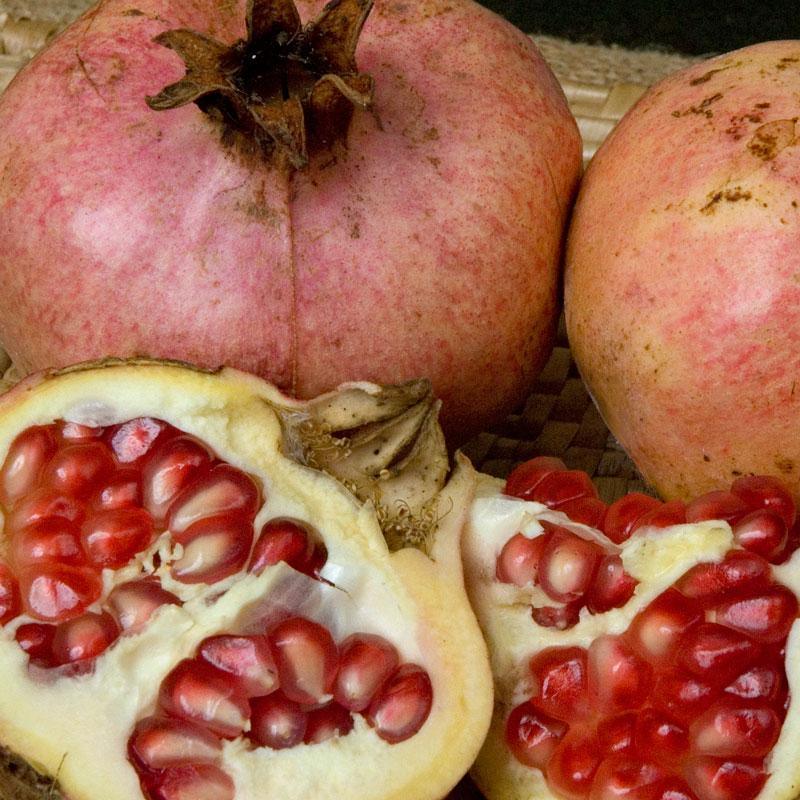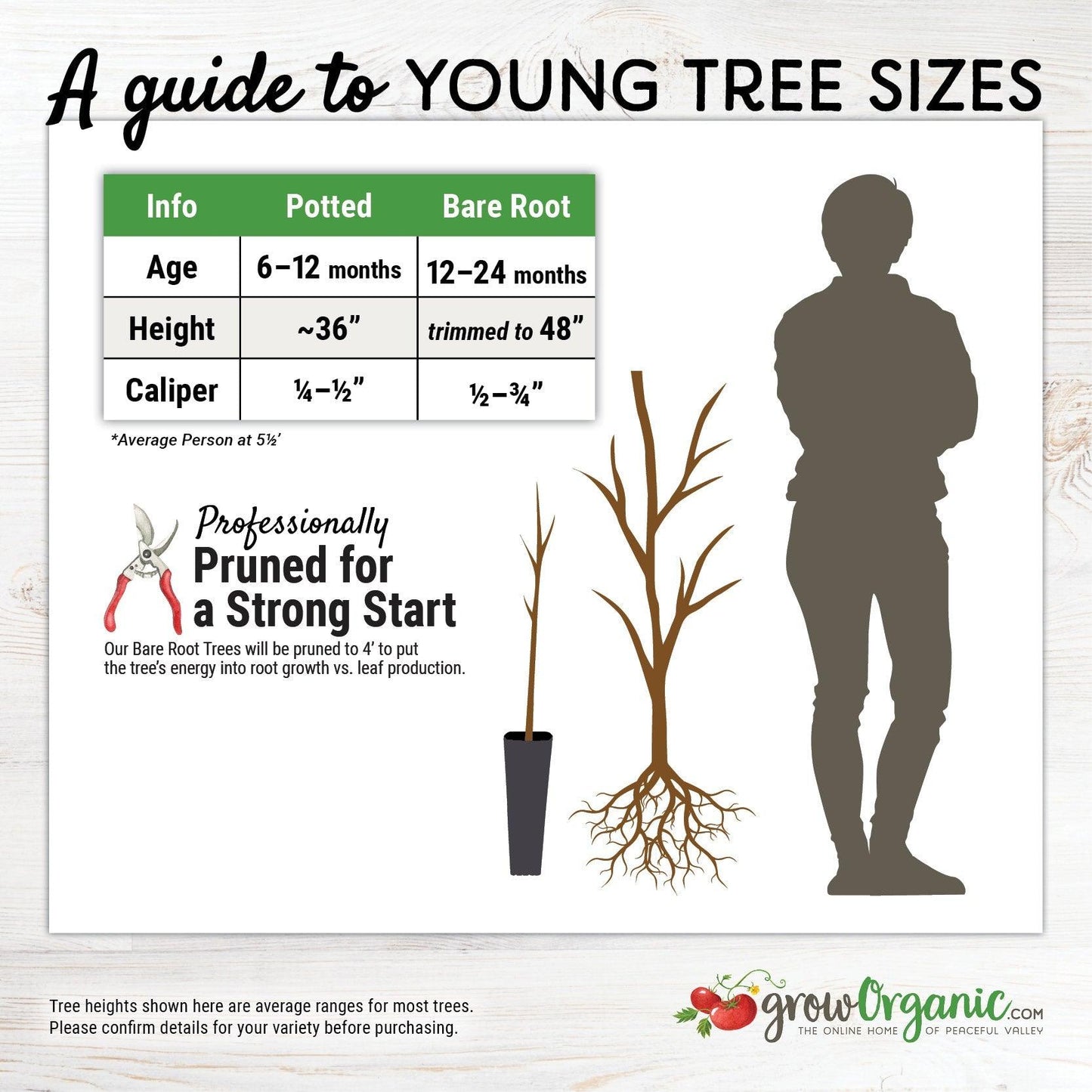Item Number: FT227
Potted Pomegranate Tree - Ambrosia
Exceptional sweetness, unique flavor.
- Zones: 8-10
- Chill hours: 150
- Harvest: September 5 - October 10
- Looks: Fantastically huge fruits up to three times the size of Wonderful with pale pink skin.
- Personality: Purple sweet-tart juice, similar to Wonderful.
- Facts of note: Pomegranates are not grafted onto any rootstock, so in areas where it gets cold enough to freeze, the tops of the plants may die back, they still come back and produce fruit. Hummingbirds LOVE the pomegranate flowers. Long-lived tree, does well in any soil with inland or coastal climates.
- Pollination: Self-pollinated.
The Ambrosia Pomegranate Tree: A Marvel of Flavor and Beauty
Pomegranates have long been cherished for their exquisite taste and vibrant, jewel-like seeds. Among the many varieties of pomegranate trees available, the Ambrosia Pomegranate stands out as a true gem in the world of fruit-bearing trees. If you're looking for an Ambrosia Pomegranate tree for sale, you’ll be delighted by this variety’s exceptional sweetness and beautiful fruit. Discover the Ambrosia Pomegranate tree, its origins, unique characteristics, care requirements, and the delightful rewards it offers to gardeners and fruit enthusiasts.
Origins of the Ambrosia Pomegranate Tree
The Ambrosia Pomegranate tree (Punica granatum 'Ambrosia') is believed to be a hybrid variety originating from California, USA. Its parentage includes the popular Wonderful Pomegranate and a variety known as Pink Satin. This carefully crafted lineage results in a tree that combines the best qualities of both its parents, creating a pomegranate tree with exceptional flavor and striking aesthetics.
Distinctive Characteristics
Appearance: The Ambrosia Pomegranate tree is a deciduous shrub or small tree, typically growing to a height of 8 to 12 feet. Its slender branches are adorned with glossy, dark green leaves that contrast beautifully with its vibrant, reddish-orange flowers. These blooms are not only visually appealing but also attract pollinators, ensuring a good fruit set.
Fruit: The Ambrosia Pomegranate tree produces medium-sized fruit that is renowned for its exceptionally sweet and flavorful seeds. The arils, or juicy seed sacs, are a delightful mix of sweet and tangy, making them perfect for snacking or adding a burst of flavor to various dishes. The fruit's exterior is a vibrant orange-red, adding to its allure.
Caring for Your Ambrosia Pomegranate Tree
Successfully growing an Ambrosia Pomegranate tree requires attention to its specific care needs. Here are some essential tips to ensure a thriving tree:
Sunlight: Plant your Ambrosia Pomegranate tree in a location that receives full sunlight for at least 6 to 8 hours a day. This ensures optimal fruit production and flavor development.
Soil: Well-draining soil is crucial for pomegranate trees. Sandy or loamy soil with a slightly acidic to neutral pH level is ideal. Proper drainage helps prevent root rot and other issues.
Watering: Pomegranate trees are drought-tolerant once established, but consistent watering is essential during the first few years to establish a healthy root system. Water deeply but infrequently to encourage deep root growth.
Pruning: Regular pruning helps maintain the tree's shape and encourages fruit production. Prune in late winter or early spring before new growth emerges.
Fertilization: Apply a balanced fertilizer in the spring to promote healthy growth and fruit development. Avoid excessive nitrogen, as it can lead to excessive foliage at the expense of fruit.
The Reward of Ambrosia Pomegranates
The Ambrosia Pomegranate tree offers a rewarding experience to gardeners and fruit enthusiasts alike. With the right care, it can provide a bountiful harvest of sweet and flavorful fruit. These versatile fruits can be enjoyed fresh, juiced, or incorporated into a wide range of dishes, from salads to desserts. Additionally, the tree's vibrant flowers and glossy leaves make it an attractive addition to any garden or landscape.
The Ambrosia Pomegranate tree is a true treasure for those who appreciate the beauty and flavor of this remarkable fruit. Its origins, distinctive characteristics, and care requirements make it a valuable addition to gardens and orchards. Whether you're a seasoned gardener or a beginner, growing an Ambrosia Pomegranate tree can be a fulfilling and fruitful endeavor, bringing the taste of ambrosia to your doorstep.
Why Buy Ambrosia Tree From Us?
We offer top-quality Ambrosia Pomegranate trees for sale, carefully grown to ensure vibrant, sweet fruit with exceptional flavor. Our Ambrosia Pomegranate trees are nurtured with expert care, making them the perfect addition to your garden for a bountiful harvest year after year.
Visit our Fruit Tree Central for a listing of all our fruit tree videos and articles.
Visit Tree Characteristics for a listing of all our fruit & nut tree growing characteristics.


Check Your Zone Compatibility:
Compatible with your zone.
Growing Zone for

Our Guarantee To You
Since 1976, we've served our customers at every stage of growing. Please contact us at any time. We are happy to support and assist you.
Shipping Information
Shipping Information
Cannot ship to the following states: HI, AK, PR, GU, VI
Shipping Weight: 5.5 lb
Dimensions: 35.9"L x 3.9"W x 3.9"H
Features
Features
- Potted
- Self-fruitful
- Suited to Warmer Climates
Characteristics
Characteristics
Planting & Care
Planting & Care
Useful Information
Useful Information
Guarantee
Guarantee
We guarantee the perishable items we sell to be in good, viable condition when we sell them. Perishable items include, but are not limited to, garlic bulbs, flower bulbs, seed potatoes, onion sets & transplants, potted or bare root trees, vegetable crowns, etc. If your perishable item arrives in substandard condition, take photographs and please contact us within 3 days of the purchase date (or delivery date) and we will provide you with a refund of the purchase price (excluding shipping costs), or a replacement. Accordingly, we urge you to open any boxes marked as ""Perishable"" immediately upon receiving them and inspect the shipment thoroughly (do not crack open heads of garlic, we do not accept claims on cracked garlic). Because some perishable items can deteriorate very quickly, we cannot accept any claims beyond the 3-day time frame as it becomes too difficult to determine if these items were delivered in substandard condition, or if they turned into such substandard condition because of having been improperly cared for or stored once delivered.
Share




Staff provided great support choosing which variety of pomegranate tree suited my desires best, and the tree itself was healthy and happy. It’s now thriving on my front patio. I’m very pleased with product and service.
Wonderful experience buying pomegranate trees from this company, all pomegranate plants were big enough, and really healthy.
Will recommend friends to buy pomegranate from this company.
Purchased this pomegranate online and picked up in store. Good nursery and very good staff. They helped us picked the online purchase and also answered our questions regarding soil type, when to plant different fruits, water requirements etc. I look forward to purchase more fruit tress in coming future.
GREAT Plants!
The Pemegranate Tree came very well wrapped and looked healthy. I highly recommend seller, very good stock and fast shipping!!







